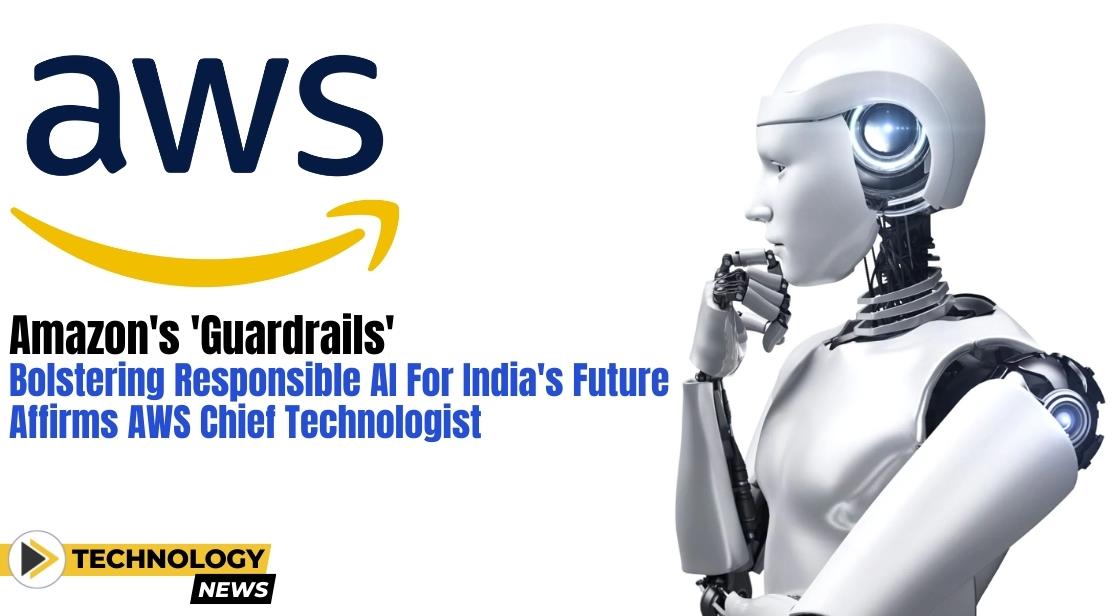Amazon's 'Guardrails': Bolstering Responsible AI for India's Future, Affirms AWS Chief Technologist

News Synopsis
Amazon's 'Guardrails' and India's Responsible AI Drive
AWS, in its recent strides towards Responsible AI, introduces 'Guardrails for Bedrock', a tool designed to filter AI model outputs. Shalini Kapoor, AWS India's Director and Chief Technologist for the Public Sector, underscores the significance of 'Guardrails' in fostering Responsible AI practices within the Indian context.
Collaborative Efforts for AI Governance
Shalini Kapoor emphasizes AWS' collaborative stance with the government to ensure Responsible AI, stressing the importance of a consultative approach and industry-government collaboration in formulating AI regulations.
Empowering Enterprises with 'Guardrails'
'Guardrails for Bedrock' empowers enterprises to establish their safety standards, allowing customization such as hate filters within Large Language Models (LLMs). Shalini highlights AWS' commitment to customer data privacy and clarifies the intent not to utilize customer data to refine AWS' models.
Amazon Q: Propelling AI Advancements
AWS' recent AI tool, Amazon Q, aimed at enhancing developer productivity and customized solutions, finds relevance in India's burgeoning digital economy, especially within the public sector.
AWS' Pivotal Role in India's Digital Transformation
Shalini underscores AWS' contribution to India's digital landscape, citing platforms like CoWin for vaccine administration and DigiLocker for digital documentation storage. The focus spans across agri-tech, state governance, education, and healthcare.
Nurturing Collaborative Health Initiatives
AWS' commitment extends to health-centric innovations, aligning with the government's vision for unified health interfaces and health IDs using Amazon Health Lake, enabling centralized and regulated patient data storage.
AWS' Impact on Healthcare Transformation
Shalini Kapoor, AWS India's Director and Chief Technologist highlights AWS' collaboration to expedite gene mapping cycles in microbiology, reducing the duration from 550 days to a mere 9 days, demonstrating the transformative potential in healthcare technology.
Reducing Gene Mapping Time with AI
AWS has partnered with the Centre of Microbiology to significantly reduce gene mapping time, bringing it down from 550 days to just 9 days. This remarkable achievement demonstrates the power of AI in healthcare research.
What is AWS HealthLake?
AWS HealthLake: Securely Store, Transform, and Analyze Healthcare Data
AWS HealthLake is a HIPAA-eligible service that enables healthcare and life sciences organizations to securely store, transform, and analyze their health data in the cloud. It offers a comprehensive set of features for ingesting, storing, querying, and analyzing diverse forms of health data, including:
- Clinical data: Electronic health records (EHRs), laboratory results, imaging reports, medication lists, etc.
- Genomic data: DNA sequences, genetic variations, and other genomic information.
- Claims data: Insurance claims data, billing codes, and other financial information.
- Social determinants of health data: Data on social factors that impact health, such as income, education, and housing.
Here are some key benefits of using AWS HealthLake:
- HIPAA compliance: Meets rigorous security and access control standards to ensure patient data is protected.
- Scalability: Can handle large volumes of data with ease and grow as your needs evolve.
- Cost-effectiveness: Pay only for the resources you use.
- Interoperability: Supports the FHIR (Fast Healthcare Interoperability Resources) standard, allowing you to integrate with other healthcare systems.
- Advanced analytics: Built-in tools for machine learning and data analytics, allowing you to extract valuable insights from your data.
- Easy to use: Offers a user-friendly interface and pre-built templates to get you started quickly.
Here are some specific examples of how AWS HealthLake can be used:
- Improve patient care: Analyze clinical data to identify trends, predict potential health risks, and personalize treatment plans.
- Reduce healthcare costs: Analyze claims data to identify areas for cost savings and improve efficiency.
- Develop new drugs and therapies: Analyze genomic data to identify new targets for drug development and personalize treatment plans.
- Conduct research: Analyze diverse types of health data to gain insights into disease patterns and develop new treatments.
Overall, AWS HealthLake is a powerful tool that can help healthcare and life sciences organizations improve patient care, reduce costs, and develop new drugs and therapies.
If you are interested in learning more about AWS HealthLake, you can visit the following resources:
- AWS HealthLake website: https://aws.amazon.com/healthlake/
- AWS HealthLake documentation: https://docs.aws.amazon.com/healthlake/
- AWS HealthLake blog: https://aws.amazon.com/healthlake/
Conclusion:
AWS's new AI tools and focus on collaboration offer promising avenues for promoting responsible AI practices in India. The company's commitment to working with the government and its successful track record in public sector projects suggest a positive outlook for responsible AI development and deployment in the country.
You May Like









